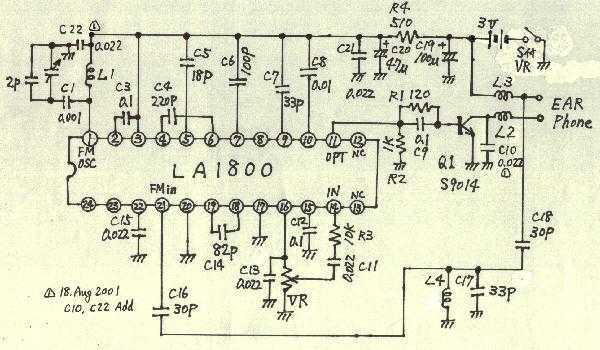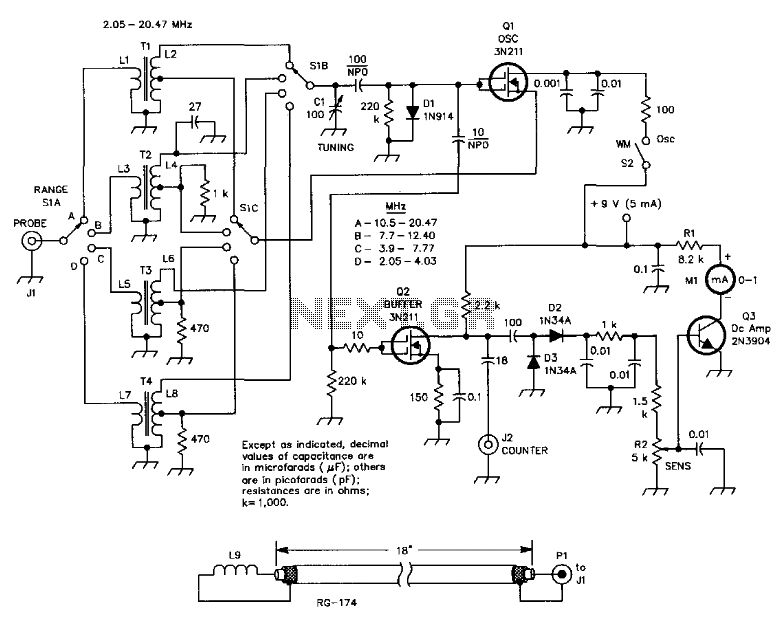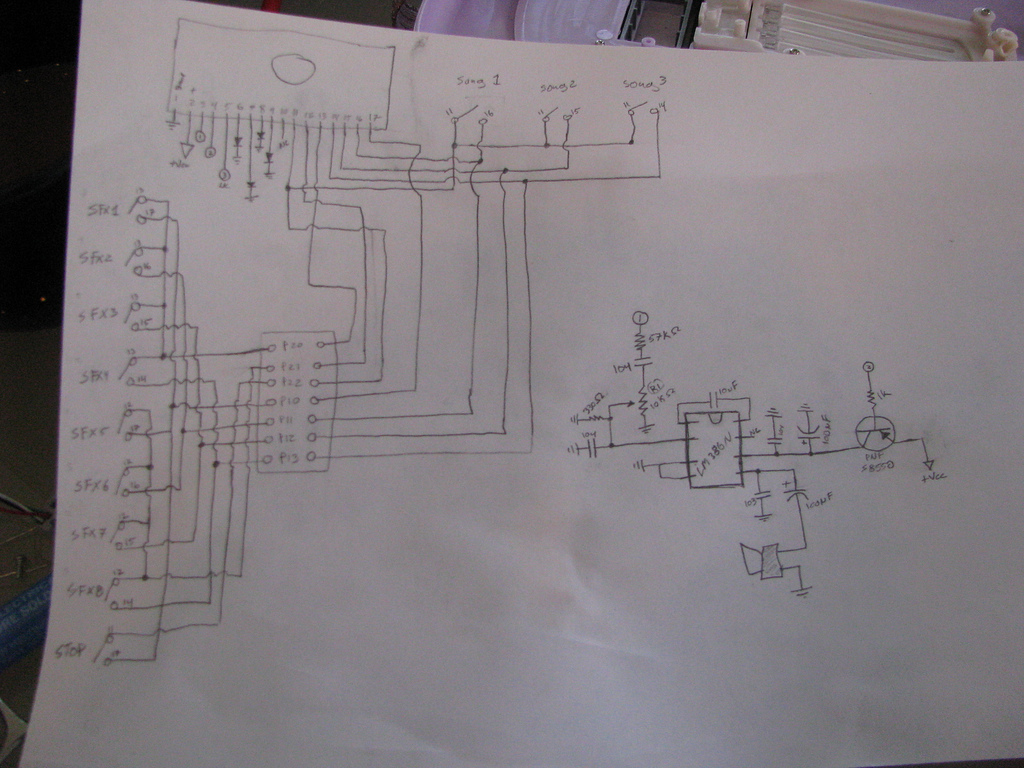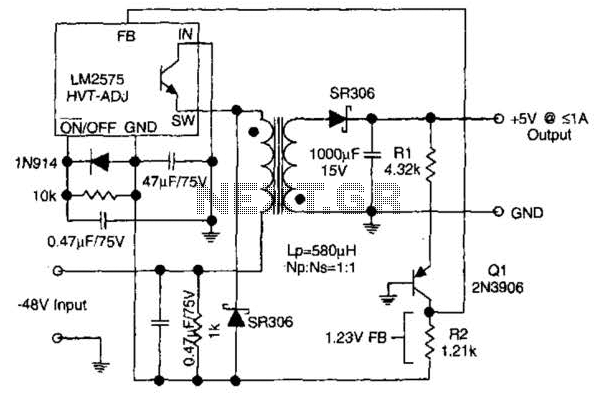
Touch Switch And Delay Circuit

This is a simple touch switch circuit where the 555 timer is configured as a one-shot multivibrator triggered by touching the touch terminal. In monostable mode, the timer generates a fixed pulse of approximately 4 seconds whenever the trigger voltage drops below Vcc/3. When the trigger pulse voltage at pin #2 falls below Vcc/3 while the timer output is low, the timer's internal flip-flop turns off the discharging transistor and causes the timer output to become high by charging the external capacitor C2, simultaneously setting the flip-flop output. The voltage across capacitor C2, VC2, increases exponentially with the time constant t = R3*C2 and reaches 2Vcc/3 at td = 1.1R3*C2. Therefore, capacitor C2 is charged through resistor R3. A greater time constant results in a longer duration for VC2 to reach 2Vcc/3. Thus, the time constant R3*C2 controls the output pulse width. When the voltage across capacitor C2 reaches 2Vcc/3, the comparator at the trigger terminal resets the flip-flop, activating the discharging transistor. At this point, C2 begins to discharge, and the timer output transitions to low. Consequently, the timer in monostable mode repeats this process. To increase the delay time beyond 4 seconds, the values of R3 and C2 must be increased. Conversely, to decrease the output time delay, the values of R3 and C2 should be reduced.
The circuit operates using a 555 timer IC configured in monostable mode, which is ideal for generating a single output pulse in response to a trigger event. The touch switch functionality allows for user interaction, enabling the circuit to be activated by a simple touch. The output pulse duration is primarily determined by the resistor R3 and capacitor C2 values, which define the RC time constant.
When the circuit is triggered by a touch, the voltage at the trigger pin (pin #2) drops below the threshold level (Vcc/3), causing the 555 timer to switch its output from low to high. This transition activates the charging process of capacitor C2 through resistor R3. The exponential charging behavior of C2 means that the voltage across it rises gradually, and the time it takes to reach 2Vcc/3 determines how long the output remains high.
Once VC2 reaches the threshold level of 2Vcc/3, the internal comparator resets the flip-flop, which in turn turns on the discharging transistor, allowing C2 to discharge. This discharging process causes the output to revert to low. The cycle then repeats, allowing for continuous operation as long as the circuit is powered and triggered appropriately.
Adjustments to the timing characteristics can be made by changing the resistor and capacitor values. For instance, increasing R3 or C2 will extend the pulse duration, while decreasing either component will shorten the delay. This flexibility makes the circuit suitable for various applications where a timed response is required, such as in delay circuits, timers, or simple control systems.
Overall, the simplicity and effectiveness of the 555 timer in monostable mode make it a popular choice for creating touch-activated circuits with adjustable timing capabilities.This is a simple touch switch circuit, the 555 timer is configured as a one shot multivibrator that is triggered by touching the touch terminal. In this monostable mode, the timer generates a fixed pulse of about 4 seconds whenever the trigger voltage falls below Vcc/3.
When the trigger pulse voltage applied to the #2 pin falls below Vcc/3 while th e timer output is low, the timer`s internal flip-flop turns the discharging Tr. off and causes the timer output to become high by charging the external capacitor C2 and setting the flip-flop output at the same time. The voltage across the external capacitor C2, VC2 increases exponentially with the time constant t=R3*C2 and reaches 2Vcc/3 at td=1.
1R3*C2. Hence, capacitor C2 is charged through resistor R3. The greater the time constant, the longer it takes for the VC2 to reach 2Vcc/3. In other words, the time constant R3*C2 controls the output pulse width. When the applied voltage to the capacitor C2 reaches 2Vcc/3, the comparator on the trigger terminal resets the flip-flop, turning the discharging Tr. on. At this time, C2 begins to discharge and the timer output converts to low. In this way, the timer operating in the monostable repeats the above process. To increase the time of the delay from 4 seconds, the value of R3 and C2 need to be increased. Similarly, to decrease the output time delay, the value of R3 and C2 need to be reduced. 🔗 External reference
The circuit operates using a 555 timer IC configured in monostable mode, which is ideal for generating a single output pulse in response to a trigger event. The touch switch functionality allows for user interaction, enabling the circuit to be activated by a simple touch. The output pulse duration is primarily determined by the resistor R3 and capacitor C2 values, which define the RC time constant.
When the circuit is triggered by a touch, the voltage at the trigger pin (pin #2) drops below the threshold level (Vcc/3), causing the 555 timer to switch its output from low to high. This transition activates the charging process of capacitor C2 through resistor R3. The exponential charging behavior of C2 means that the voltage across it rises gradually, and the time it takes to reach 2Vcc/3 determines how long the output remains high.
Once VC2 reaches the threshold level of 2Vcc/3, the internal comparator resets the flip-flop, which in turn turns on the discharging transistor, allowing C2 to discharge. This discharging process causes the output to revert to low. The cycle then repeats, allowing for continuous operation as long as the circuit is powered and triggered appropriately.
Adjustments to the timing characteristics can be made by changing the resistor and capacitor values. For instance, increasing R3 or C2 will extend the pulse duration, while decreasing either component will shorten the delay. This flexibility makes the circuit suitable for various applications where a timed response is required, such as in delay circuits, timers, or simple control systems.
Overall, the simplicity and effectiveness of the 555 timer in monostable mode make it a popular choice for creating touch-activated circuits with adjustable timing capabilities.This is a simple touch switch circuit, the 555 timer is configured as a one shot multivibrator that is triggered by touching the touch terminal. In this monostable mode, the timer generates a fixed pulse of about 4 seconds whenever the trigger voltage falls below Vcc/3.
When the trigger pulse voltage applied to the #2 pin falls below Vcc/3 while th e timer output is low, the timer`s internal flip-flop turns the discharging Tr. off and causes the timer output to become high by charging the external capacitor C2 and setting the flip-flop output at the same time. The voltage across the external capacitor C2, VC2 increases exponentially with the time constant t=R3*C2 and reaches 2Vcc/3 at td=1.
1R3*C2. Hence, capacitor C2 is charged through resistor R3. The greater the time constant, the longer it takes for the VC2 to reach 2Vcc/3. In other words, the time constant R3*C2 controls the output pulse width. When the applied voltage to the capacitor C2 reaches 2Vcc/3, the comparator on the trigger terminal resets the flip-flop, turning the discharging Tr. on. At this time, C2 begins to discharge and the timer output converts to low. In this way, the timer operating in the monostable repeats the above process. To increase the time of the delay from 4 seconds, the value of R3 and C2 need to be increased. Similarly, to decrease the output time delay, the value of R3 and C2 need to be reduced. 🔗 External reference





